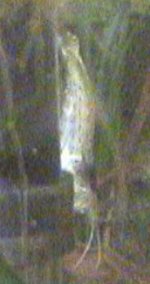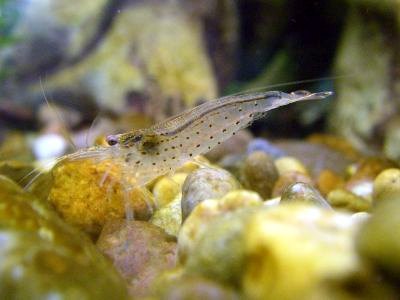 |
 |
|
|
Last Updated: 2/21/14

Amano Shrimp Information
My Amano Shrimp
Amano Shrimp Photos
Survive in aquariums: Yes
Survive in warm ponds: Not recommended
Survive in cold ponds: No
Plant eating capacity: Low
Algae eating capacity: Moderate to High
The Amano shrimp, named after the person who introduced it to aquarists, is called by the following additional names: Yamato Numa Ebi, Japanese Marsh Shrimp, Yamato, and Caridina japonica (the scientific name). Some people say Cardinia instead of Caridina. I was unable to find which was accurate. Note that around September 2006, scientists renamed the Amano shrimp to Caridina multidentata. Here is a link about it (this is an archived version as the site no longer exists). The Amano shrimp looks somewhat like the rainbow shrimp I have kept. Apparently, it is rare to find one in the United States. This shrimp prefers brackish (which means some salt, between freshwater and seawater) waters and grows to about two inches. They should be kept below 80 degrees F since they are not a tropical species. Temperatures in the 60's and 70's are preferred.
They have not spawned often in captivity because they require saline waters with lots of
plankton. The larvae require brackish water to grow. A female can carry 1000 to 2000 eggs so
the larvae are very small and need protozoans and algae to eat. Some breeding is reported in
Germany. One idea is that Amano shrimp naturally live in streams and release their eggs there.
Then the larvae float to the sea where they undergo nine changes before migrating back into the
streams.
One aquarist had success breeding the shrimp by alternating cycles of lights on for a few weeks
with a week of lights off. The dark period apparently allowed the baby shrimp to remain
"invisible" to hungry adult shrimp and small fish. Java moss and Amazon swords were the
predominate plants in the tank.
Amano shrimp are brown with a tan stripe down their back and brown lines on their sides according to one report but that describes my rainbow shrimp! Most photos of Amano shrimp show a shrimp that looks nothing like that. They are mostly clear with spots along their sides. They lack large claws and live longer than most freshwater shrimp. They are supposed to eat soft and red algas. Unlike other shrimp, one shrimp web site says that they eat directly with their mouth and do not use their hands while a few people who have kept them say that they do use their hands (they have seen it and so have I).
On 2/1/02, I added three shrimp sold as "Japonica" shrimp to my 20 gallon tank. One was dead the next morning. They were larger and lighter than my rainbow shrimp and had little dashes along their sides. They liked to sit on leaves and used their little hands to bring algae to their mouths. I have seen it! I hoped they could survive in my tank. A photo is above but it is not very good. By 5/10/02, I had not seen the Amano shrimp in many months. They were presumed dead. I did see a rainbow shrimp in that tank on 5/4/02 though which I had not seen in a long time so who knows. Update 1/24/12: The Amano shrimp were never seen again so they only lived about three months in my tank.

Here is yet another great Amano photo from Kingsley on 2/4/05: Amano Shrimp
On 1/2/08, Ben sent this photo of an Amano shrimp.
Amano shrimp
He also sent this photo of a "Cardinia sp. 'dark green' female," perhaps
Caridina babualti var. Green.
Shrimp
|
|
Pet Link Banner Exchange: |

|
|
|
Return to the main crustacean page.
See the master index for the crustacean pages.

|

|
E-mail RobynCopyright © 1997-2026 Robyn Rhudy |

|
 |